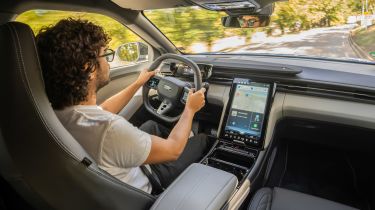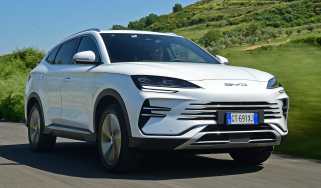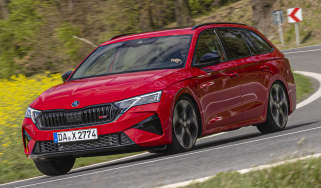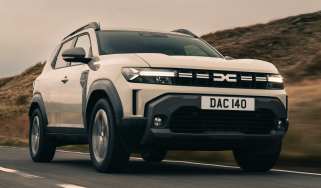Ford Capri - Engines, performance & drive
In using VW’s latest powertrain elements, the Capri has adopted some exceptionally smooth powertrains, just don’t go thinking it’s sporty
The good news is that VW’s technical toolkit is a fine one to draw from, as the various refinements that come with its recent upgrades start the Capri on the front foot. Single-motor variants with the 77kWh battery pack produce 282bhp and 545Nm of torque, hitting 62mph 6.4 seconds with the top speed limited to 111mph. This is a good amount of power for the Capri, without feeling excessive, but it’s the torque that helps it feel effortless in a very satisfying, almost GT-like fashion.
Pin your foot to the floor and there’s no rampant acceleration, rather a gentle surge that makes light work of the Capri’s near-2.1 tonne weight. The powertrain is also impressively refined, with no discernable motor whine and good throttle calibration. As with VW, Ford offers two levels of regenerative braking, with the standard ‘D’ coming with very gentle regen akin to standard engine-braking on an ICE car, with ‘B’ upping this to a more forceful level. It won’t bring you to a complete stop, mind.
Dual-motor variants run a slightly larger 79kWh battery pack, and produce a combined 335bhp power figure with 679Nm of torque. The extra performance is noticeable, and drivers after a more secure driving experience in low-grip situations will appreciate the extra traction, but in day-to-day driving, we think most will prefer the extra range available to the single-motor, not to mention the lower price point.
More reviews
All Capris have four different drive modes, made up of Comfort, Sport, Eco and a configurable Individual mode, but we found the difference between modes to be marginal at best. Sport does little to increase performance or engagement, and without the option of adjustable dampers, there’s no difference to the ride quality or body control either.
That’s no bad thing, as on both counts the Ford feels well resolved. The ride is especially impressive, with a good level of compliance over rough roads and a polished slickness to sharp intrusions on the road, such as speed humps or manhole covers. The steering is also well weighted and accurate, and feels matched to the Capri’s level of performance.
| Model | Power | 0-62mph | Top speed |
| Ford Capri 55kWh | 168bhp | 8.7 seconds | 99mph |
| Ford Capri 77kWh | 282bhp | 6.4 seconds | 111mph |
| Ford Capri 79kWh | 335bhp | 5.3 seconds | 111mph |
What is the Ford Capri like to drive?
In town
Smooth and consistent throttle and brake pedals make the Capri an easy car to pilot around urban centres, despite having limited options for regenerative braking. Visibility all-round is fine, but if you like to sit low, the high-dash can limit forward visibility. But with time, you soon get to grips with Capri’s square-sided body making it no less difficult to drive than the more upright and boxy Explorer, or indeed the closely related ID.4.
On A- and B-roads
Speed up a bit and the Capri’s ride and handling is secure and stable, with none of the ‘bobble’ that can sometimes affect electric cars with a high driving position. The ride is controlled and well-rounded, with a plushness that helps keep it comfortable, while retaining a good connection to the road.
By comparison, something like a VW ID.4 can feel more disconnected and floaty, although high-spec models fitted with the optional adaptive dampers claw back some of the missing control.
However, the fact Ford does without any form of adaptive dampers while retaining good balance is testimony to the engineering excellence inherent within Ford’s chassis department
On the motorway
Ford’s well-judged compromise is as evident on the motorway as it is on slower roads. The ride finds a good flow, and even on the larger 20-inch wheels of the upper models, it’s never crashy or too firm. The steering’s relatively slow ratio also helps on the motorway to create a calm and concise feel to the chassis.






